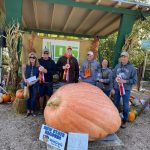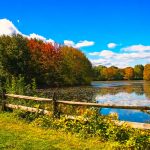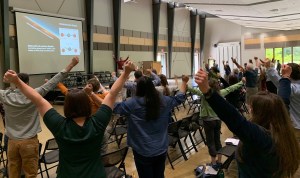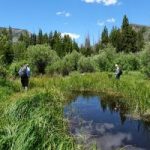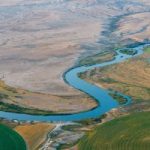LANDER—Frustrated by state and federal inaction on climate change, community organizers have begun taking action in several Wyoming towns by showing the cost savings of energy efficiency measures and nudging municipal leaders toward small-scale renewable energy.
It’s a start, but not enough, Lander resident Ariel Greene said. The conversation about how climate change is already transforming Wyoming landscapes and threatening communities must become more inclusive and prominent, he told attendees of the inaugural Wyoming Climate Summit.
 Signs posted at the inaugural Wyoming Climate Summit June 25 at the Lander Community and Convention Center. (Dustin Bleizeffer/wyomingdigest.com)
Signs posted at the inaugural Wyoming Climate Summit June 25 at the Lander Community and Convention Center. (Dustin Bleizeffer/wyomingdigest.com)
“The good news is that we have a fair idea about how to do this and much of the technology is available to do it,” said Greene, co-organizer of the summit. “It’s just that we’re not prioritizing the need to act now, collectively, and at speed and scale. We need many more people working on this problem.”
About 200 people attended the Saturday event, organized by the Lander Climate Action Network. The summit featured discussions on initiating and sustaining local climate action, as well as strengthening ties between climate science and community sustainability through traditional Native American ecological knowledge.
“[Traditional ecological knowledge] helps engage communities and science partnerships,” said Margaret Redsteer, an enrolled member of the Crow Tribe and assistant professor in the School of Interdisciplinary Arts & Sciences at the University of Washington. “When people see that their own observations are being acknowledged and that their own observations aren’t just something of a fluke that they happen to see, it is really, really a powerful thing.”
Turning frustration into action
The same frustration with inaction spurred the Greater Yellowstone Coalition and regional scientists to study the current and projected impacts of climate change in and around Yellowstone National Park.
Bryan Shuman, director of the University of Wyoming-National Park Service Research Center in Grand Teton Park co-authored the Greater Yellowstone Climate Assessment. The study, published in 2021, confirms critical changes already underway in six watersheds due to declining snowpack and warming temperatures. Using such information to encourage conversations at the local level is as important as the science itself, according to Shuman.
“This is exactly why we did the Greater Yellowstone Climate Assessment — to facilitate discussions like this,” Shuman told Wyoming Climate Summit attendees.
“It’s clear to me that doing something is better than nothing, and I think that’s really motivating.”
Cody Pitz, Sunrise Movement of Jackson
The hydrological and ecological changes that are already occurring in the region will only intensify, Shuman said. To what degree, however, depends on local policies and actions that must be part of a global response.
“We’re not totally doomed here,” Shuman said, adding that the far range of global temperature modeling can be avoided. “We’re going to face change, that’s unquestionable. But we have a lot of choices before us as to how to approach [climate change]. I think the biggest uncertainty about the future isn’t the physics of the climate system — it is what are our choices going to mean.”
Hope and local knowledge
Cody Pitz, a coordinator for the Jackson chapter of the Sunrise Movement, said a lot of young people he talks with about climate change are frustrated to the point of giving up. However, messages he heard at the Wyoming Climate Summit gave him more hope.
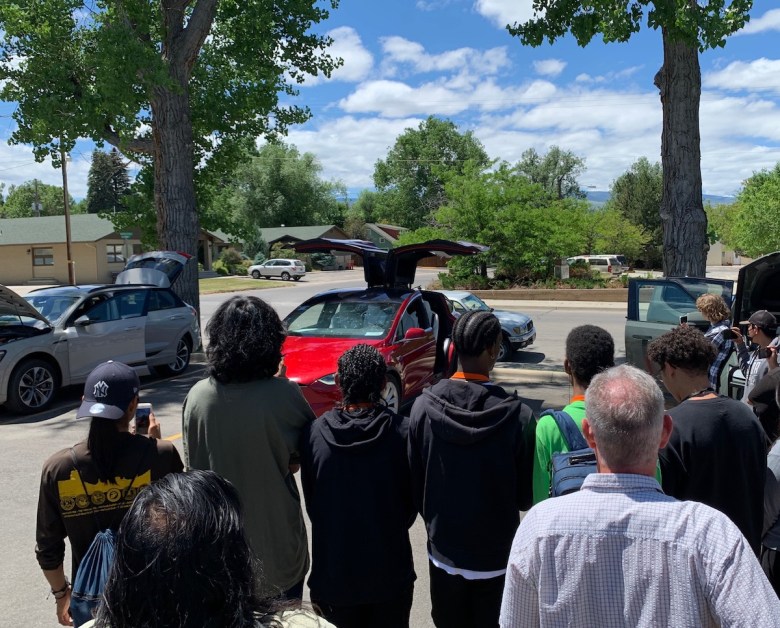 Wyoming Climate Summit attendees watch a demonstration of automation capabilities during the event’s electric vehicle car show June 25 in Lander. (Dustin Bleizeffer/wyomingdigest.com)
Wyoming Climate Summit attendees watch a demonstration of automation capabilities during the event’s electric vehicle car show June 25 in Lander. (Dustin Bleizeffer/wyomingdigest.com)
“It’s clear to me, based on politics and society, that we will not reach the levels [limiting global temperature rise] that a lot of us would like to, to have a more livable planet,” Pitz said. “But it’s clear to me that doing something is better than nothing, and I think that’s really motivating.”
The climate conversation must include and prioritize Indigenous people — a realization that is gaining traction among those advocating for climate action, Redsteer said. Indigenous people all over the world have adapted to changing ecosystems, and their responses are rooted in community and living sustainably with what each landscape offers.
“There’s nobody more resilient than a tribal community,” Redsteer said. “One of the things about Indigenous and local knowledge is it really is focused on living within the natural world and all of our relations to the ecosystems in the land and animals — all of the beings around us.”
The post Inaugural Wyoming Climate Summit encourages local, collective action appeared first on wyomingdigest.com.



